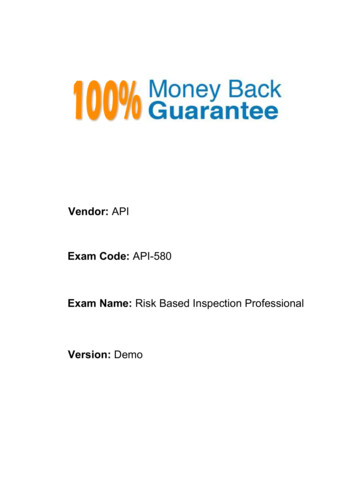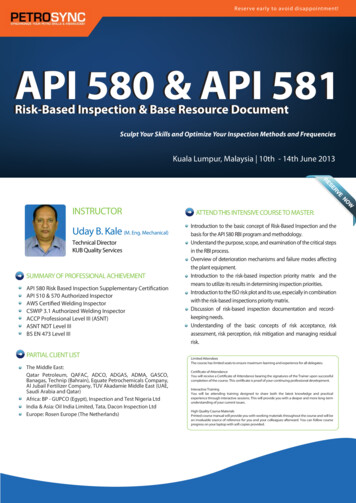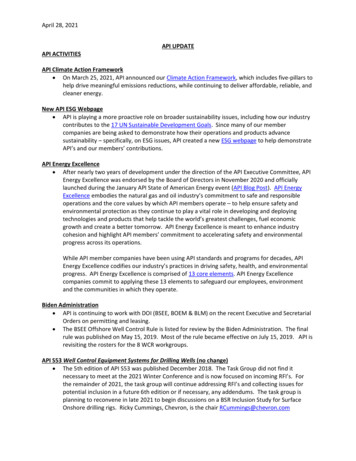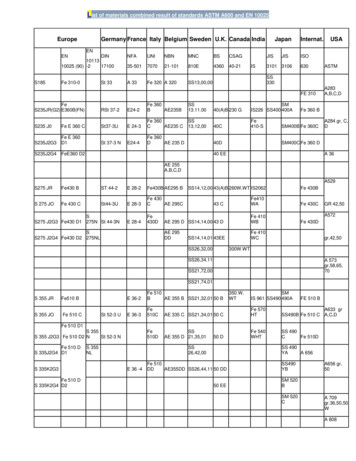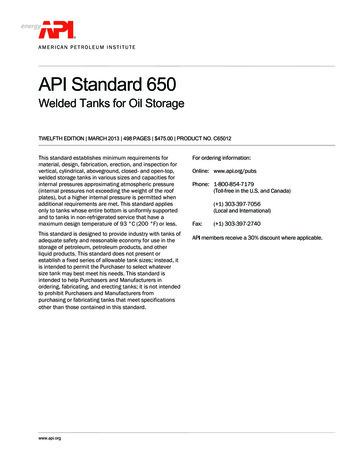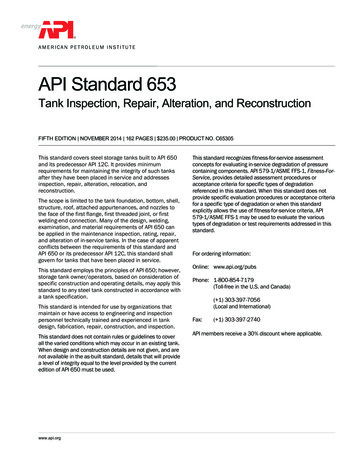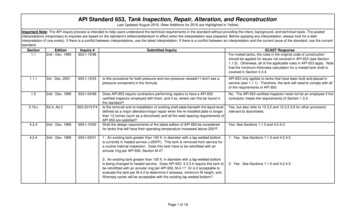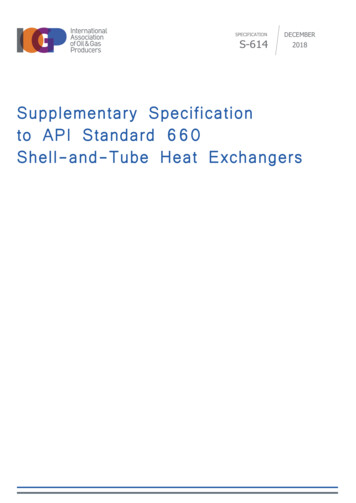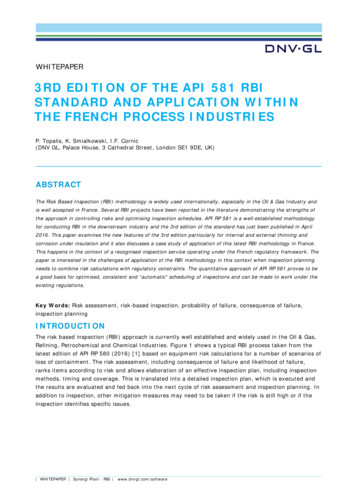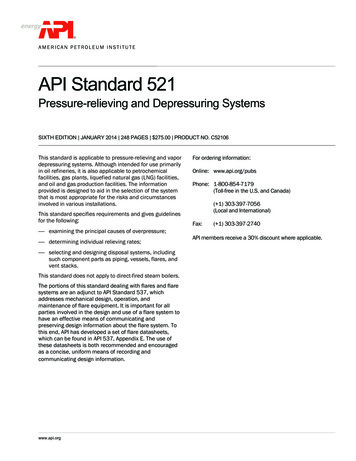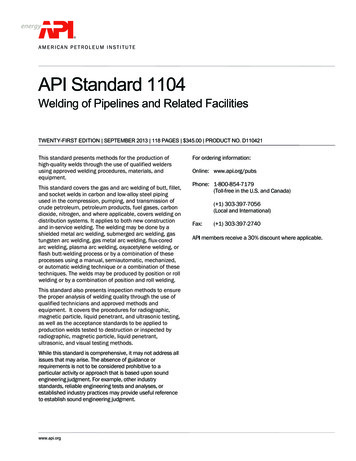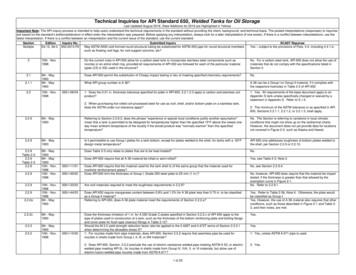
Transcription
Technical Inquiries for API Standard 650, Welded Tanks for Oil StorageLast Updated August 2016. (New Additions for 2016 are Highlighted in Yellow)Important Note: The API inquiry process is intended to help users understand the technical requirements in the standard without providing the intent, background, and technical basis. The posted interpretations (responses) to inquiriesare based on the standard’s edition/addendum in effect when the interpretation was prepared. Before applying any interpretation, always look for a later interpretation (if one exists). If there is a conflict between interpretations, use thelatest interpretation. If there is a conflict between an interpretation and the current issue of the standard, use the current standard.SectionMultipleEditionEd 12, Ad 022.12.1.12.2Submitted InquiryMay ASTM A500 cold formed round structural tubing be substituted for ASTM A53 pipe for round structural memberssuch as floating roof legs, for roof support columns, etc?SCAST ReponseYes – subject to the provisions of Para. 4.4, including 4.4.1.d.10th - Nov.1998Do the current rules in API 650 allow for a carbon steel tank to incorporate stainless steel components such asnozzles or an entire shell ring, provided all requirements of API 650 are followed for each of the particular materialtypes (CS or SS) used in the structure?No. For a carbon steel tank, API 650 does not allow the use ofmaterials that do not comply with the specifications listed inSection 2.9th - May19939th - May1993Does API 650 permit the substitution of Charpy impact testing in lieu of meeting specified chemistry requirements?No.What API group number is A 36?A 36 can be a Group I or Group II material, if it complies withthe respective footnotes in Table 2-3 of API 6501: Does the 0.01 in. thickness tolerance specified for plate in API 650, 2.2.1.2.3 apply to carbon and stainless coilproduct?1: Yes. All requirements of the base document apply to anAppendix S tank unless specifically changed or waived by astatement in Appendix S. Refer to S.1.5.10th - Nov.1998Inquiry No.650-2013-F8650-I-06/042: When purchasing hot-rolled coil-processed steel for use as roof, shell, and/or bottom plate on a stainless tank,does the ASTM under-run tolerance apply?2: The minimum of the ASTM tolerance or as specified in API650, Sections 2.2.1.1, 2.2.1.2, or 2.2.1.3, shall apply.2.2.99th - May1993Referring to Section 2.2.9.3, does the phrase "experience or special local conditions justify another assumption"mean that a tank is permitted to be designed for temperatures higher than the specified 15 F above the lowest oneday mean ambient temperature of the locality if the stored product was "normally warmer" than this specifiedtemperature?No. The Section is referring to variations in local climaticconditions that might not show up on the isothermal charts.However, the document does not yet provide data for locationsnot covered in Figure 2-2, such as Alaska and Hawaii.2.2.99th - May1993Is it permissible to use Group I plates for a tank bottom, except for plates welded to the shell, for tanks with a -50 Fdesign metal temperature?API 650 only addresses toughness of bottom plates welded tothe shell, per Section 2.2.9 or 2.2.10.9th - May19939th - May199310th - Nov.199810th - Nov.1998Does Table 2-3 only relate to plates that are to be heat-treated?No.Does API 650 require that all A 36 material be killed or semi-killed?Yes, see Table 2-3, Note 2.No, see Section 2.2.9.4.650-I-49/02Does API 650 require that the material used for the tank shell is of the same group that the material used formanhole reinforcement plates?Does API 650 limit the thickness of Group I, Grade 250 steel plate to 25 mm (1 in.)?650-I-33/03Are roof materials required to meet the toughness requirements in 2.2.9?650-I-44/03Does API 650 require manganese content between 0.8% and 1.2% for A 36 plate less than 0.75 in. to be classifiedas a Group II material?Referring to API 650, does A 36 plate material meet the requirements of Section 2.2.2.a?Yes. Refer to Table 2-3b, Note 6. Otherwise, the plate wouldbe classified as Group I.Yes. However, the use of A 36 material also requires that otherconditions, such as those described in Figure 2-1 and Table 23, and their notes, are met.Does the thickness limitation of 1 in. for A 283 Grade C plates specified in Section 2.2.2.c of API 650 apply to thetype of plates used in construction of a tank, such as the thickness of the bottom reinforcing plate and bolting flangeand cover plate for flush-type cleanout fittings in Table 3-12?Should the M.3.2 yield strength reduction factor also be applied to the 0.426T and 0.472T terms of Section 2.3.3.1when determining the allowable stress S?1: For nozzles made from pipe materials, does API 650, Section 2.5.2 require that seamless pipe be used fornozzles in shells made from Group I, II, III, or IIIA materials?Yes.2: Does API 650, Section. 2.5.2 preclude the use of electric-resistance welded pipe meeting ASTM A 53, or electricwelded pipe meeting API 5L, for nozzles in shells made from Group IV, IVA, V, or VI materials, but allow use ofelectric-fusion-welded pipe nozzles made from ASTM A 671?2: Yes.2.2.9Table 2-32.2.9Table 2-32.2.92.2.92.2.92.2.92.2.2a10th - Nov.199810th - Nov.19989th - May19932.2.2c9th - May19932.3.39th - May199310th - Nov.19982.5.2650-I-11/01650-I-15/001 of 25No, however, API 650 does require that the material be impacttested, if the thickness is greater than that allowed by theexemption curve in Figure 2-1.No. Refer to 2.2.9.1.Yes.1: Yes, unless ASTM A 671 pipe is used.
Section2.7Edition9th - May199339th - May1993Inquiry No.3.1.3.510th - Nov.1998650-I-37/033.1.3.510th - Nov.1998650-I-49/033.1.53.1.5Figure 3-3a3.1.5.43.1.5.83.1.5.83.1.5.93.2.49th - May19939th - May19939th - May199310th - Nov.199810th - Nov.199810th - Nov.19989th - May1993Submitted InquiryReferring to API 650, Section 2.7, are bolt heads required to be marked according to ASME Section II, Part A forbolting?SCAST ReponseNo. Refer to the applicable ASTM bolt specification, which mayor may not be identical to the parallel ASME bolt specification.Please furnish details on the maximum allowable tank diameter and height for tanks built in accordance with API650.The appropriate combination of tank diameter and height is adesign consideration. There are several factors which influencethis. API 650 does not cover an explanation of these factors.Please note the thickness limitations given in Section 2.2.2.Is it the intent of 3.1.3.5 to limit the maximum lap of a double welded lap joint to 2 in. and a single welded lap joint to1 in. If not, is there a maximum lap requirement for single welded lap joint bottoms and roofs? Would this constraint,if any, also apply to bottom or roof repair or replacements governed by API 653.1: Section 3.1.3.5 of API 650 specifies minimum lap joint dimensions. Is there any limit on the maximum width of alap joint?No.2: Can a lap joint consisting of two (2) ¼ in. plates be lapped 3 in.?What is the distance between vertical 1: API Standard 650 does not address maximum lap.2: Yes. Any lap that exceeds the minimum is acceptable.Refer to 3.1.3.5.Please refer to API 650, Section 3.1.5.2.b and Section 3.7.3.Referring to API 650, Section 3.1.5 and Figure 3-3a, is it permissible to lap roof plates with the inner (upper) platelapping under the lower (outer) plate, to protect against the tank contents condensing in the lap joint on the undersideof the roof?Referring to API 650, Section 3.1.5.4, is it required to make a full fillet lap seam weld (top side only) under the tankshell?Referring to Section 3.1.5.4, for lap welded bottoms and roofs, are standard mill edge plates considered to be“reasonably square edged”?1: Referring to API Standard 650 3.1.5.8 (b) and Figure 3-20, is it mandatory to provide welding between the bottomside of a wind girder plate/section and the tank shell if not specified by the purchaser?Yes, the details shown represent the typical or most commondetails, but other details are also permitted.2: Is it mandatory to seal-weld the bottom of the weld joints joining ring sections of the wind girder?2: Section 3.1.5.8 (a) requires this to be a full-penetration buttweld.Is there any allowance or provision to omit the top angle as required by API 650, 3.1.5.9e and 3.1.5.9f if we can showby calculation that the top compression area is sufficient.Does API 650 cover the design of a tank for a design vacuum condition of 50 mm of water?No.Should the vacuum relief system set pressure be 25 mm of water if the required design vacuum condition is 50 mmof water?API 650 does not cover the required setting for vacuumrelieving systems. The vacuum relieving systems should beadequately sized to limit the partial vacuum to 1 in. of watervacuum (roughly 25 mm of water). Refer to API Std. 2000,Section 3.6.1.2.Can tanks that are designed to exceed 1 in. external pressure have an API nameplate?Yes. API 650 does not contain design rules covering externalpressure exceeding 1 in. water column.Yes.Yes.1: This is a purchaser specified option for details a, b, c and eof Figure 3-20. It is required for detail d of Figure 3-20.No. Per API 650 Section 3.2.4, the tank is limited to one in. ofwater vacuum (roughly 25 mm). If the tank must be designedfor 50 mm water vacuum, then this is a special design which isnot covered by API 650.3.2.49th - May19933.2.410th - Nov.19983.49th - May199310th - Nov.1998Is a repad allowed to go to the tank bottom and intersect the bottom at 90 degrees to the bottom?Yes.Is it acceptable for the primary (upper) bottom, of an API 650 Appendix I double-bottom tank to not project throughthe shell and to be attached only to the inside of the shell?No. API 650, Section 3.4.2 requires the bottom plate project atleast 25 mm (1 in.) outside the toe of the outer shell-to-bottomweld. Section 3.5.2 requires the annular plate project at least50 mm (2 in.) outside the shell. Furthermore, Section 3.1.5.7requires the bottom be welded to the shell on both sides of theshell. The only way this can be accomplished is with a shellprojection. Figure I-4 illustrates an acceptable double-bottominstallation.10th - Nov.1998Can a bottom rectangular plate, as described in API 650, Section 3.4.1, be smaller than 72 in. x 72 in.?Yes, if the purchaser agrees to the reduced width. There is norequirement that the length be at least 72 in.3.43.4.1650-I-20/032 of 25
Section3.5Edition9th - May19933.53.53.5.2Submitted InquiryDoes API 650 require that tank annular plates be the same material as the bottom shell course?SCAST ReponseNo. However, the annular plate material must meet thetoughness requirement of Section 2.2.9. See Section 2.2.9 1and Figure 2-1.9th - May1993Does API require an annular plate to be used if (1) bottom plates (1/2 in. nominal thickness) are butt welded and100% radiographed, and (2) the bottom shell course material falls under Group IV or V, and (3) the materials are notCharpy tested?The requirement to provide an annular plate depends upon thematerial group and the stress levels in the bottom shelfcourse. Refer to Section 3.5.1. The question cannot beanswered without more information being provided. Bottomplate thickness, the NDE applied, and the material toughnessare not factors in the decision.9th - May1993Does API 650 prohibit installing the bottom annular plates on top of the ¼ in. bottom plates? If allowed, this optionwould eliminate an area for water to collect causing corrosion.Except for the flush-type cleanout connections (see Figures 311 and 3-12), there is no requirement that the bottom platemust lap above, or must lap under the annular plate.10th-add. 4Inquiry No.650-I-05/07Background : As per 3.5.2 minimum radial width of annular plate shall be(1) 600 50 (outside projection) 50 (lap joint) 7 (shell thickness)which is 717 mm(2) As per equation {215*tb/(H*G) 0.5} {215*9/(7*1.04) 0.5} 717 mmAccordingly 800 mm radial width used. However, if we add outsideprojection lap joint width shell thickness ( 107 mm) on calculated width,then it becomes 824 mm (717 107) which exceed the used width.Question : Is projection outside the shell (as per 3.4.2) and lap jointwidth is required to be added when calculated as per equation given in3.5.2?pending3.5.210th - Nov.1998650-I-22/03Section 3.5.2 states the annular bottom plates shall have at least a 50 mm projection outside the shell. Is thereference point to calculate the projection located on the outside or inside diameter of the shell?The reference point is on the outside diameter of the shell plate,as stated in 3.5.2.3.610th - Nov.19989th - May1993650-I-02/03Does API 650 require same width and material for all shell courses?No.If the calculated shell thickness is 1/8 in. and the specified corrosion allowance is 1/8 in., must the shell thickness beobtained by adding the 1/8 in. to the minimum thicknesses required by Section 3.6.1.1, which would be 1/8 plus 3/16in., or can it be determined by adding the corrosion allowance to the computed required minimum thickness, in thiscase 1/8 in. plus 1/8 in.?The minimum thickness requirements of Section 3.6.1.1 areprimarily for fabricability. The corrosion allowance may beadded to the computed shell minimum thickness, in this case,1/4 in. total.10th - Nov.1998650-I-50/001: Referring to API 650, Section 3.6.1.2 and Section 3.1.5.2, is it permissible for the tank manufacturer, with orwithout the purchaser’s consent, to seam weld two plates (circumferentially) then join the two with one vertical weld,thus intersecting the horizontal weld?Reply 1: No. See 3.1.5.2b.2: Is a shell course considered from one circumferential weld to the next circumferential weld, assuming 72 in.minimum width as stated in Section 3.6.1.2?A client has specified 6 crude oil tanks with an operating temperature of 70ºF - 100ºF and a design temperature of300ºF and a material of construction of A 285 Grade C. Should the tanks be designed wit
API 650 does not cover the required setting for vacuum relieving systems. The vacuum relieving systems should be adequately sized to limit the partial vacuum to 1 in. of water vacuum (roughly 25 mm of water). Refer to API Std. 2000, Section 3.6.1.2. 3.2.4 10th - Nov. 1998 650-I-20/03 Can tanks that are designed to exceed 1 in. external pressure have an API nameplate? Yes. API 650 does .
![API Ballot: [Ballot ID] – API 510 & API 570, Deferrals, Rev05](/img/5/api510andapi570deferralsrev5.jpg)
